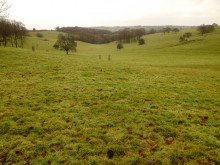There has been much written about Rampisham Down in the last week. I have been very busy helping with the social media campaign (and trying to do other work) but felt compelled to start this series of factcheck blogs to help people interested in the case understand the issues.
Today the Factcheck is about Lowland Acid Grassland. Lowland Acid Grassland is not the most exciting habitat in the world. It often looks like the photo above, which I took recently on teh part of Rampisham Down that is not surrounded by barbed wire with Ghurka security guards. This bit is also not in the SSSI. I was delighted then to find essentially unimproved lowland acid grassland here.
Lowland Acid Grassland is very much the poor cousin of England’s unimproved grasslands: it often doesn’t have the beauty of wildflower meadows, or the species-richness of chalk downlands. It had long been neglected by conservationists too busy with other species and habitats – and it was often regarded as merely a degraded form of lowland heathland. In some senses this is true, in the same way that lowland heathland could be regarded as a degraded form of woodland. The millions of hectares of acid grassland that covers the hills of upland Wales is rightly castigated as sheep-wrecked by George Monbiot, though it is quite funny how he delights in finding some flowers, acid grassland flowers, on an ungrazed road verge, in Feral. It was only with the advent of Biodiversity Challenge in 1994 and the subsequent Biodiversity Steering Group report in 1995, that Lowland Acid Grassland became recognised as a valuable habitat in its own right and worthy of conservation effort. 20 years on we know much more about it how much is left, and why it is important.
Although it can often look rather dull, especially if it has been overgrazed, or neglected, Lowland Acid Grassland can be surprisingly rich in wildlife, and support rare species.
Professor Ghillean Prance, former Director of Kew Gardens, presented evidence to the West Dorset Planning Committee in support of the application to build a solar farm on Rampisham Down. He unashamedly used his botanical credentials, explaining to the committee how many books and papers he had published, before stating that he had walked over Rampisham down and found “degraded impacted habitat” with “nothing especially rare” and concluded it had “no botanical species of great concern”.
The Botanical Society of Britain and Ireland, an organisation I have worked with for the past 25 years; and the pre-eminent authority on the status of British wild plants, have recently published the England Red List for Vascular Plants.
For anyone interested in conservation or natural history it is worth reading. It is an extraordinarily powerful piece of research. The BSBI have looked again at the status of the 1500 or so wild plants in England and re-assessed their status, using internationally adopted criteria. A surprisingly large number of flowers have been assessed as Red-list Near Threatened. This means these species are in real trouble in England, mostly due to a significant shrinkage in their distribution – they have disappeared altogether from large parts of England, especially lowland England.
After the planning committee meeting, I asked Professor Prance if he was aware of the new England red data list and he confirmed that he was.
I have looked through the species lists for Rampisham. The Lowland Acid Grassland and the vanishingly rare, possibly unique areas of acid/chalk grassland there support Nine Red Data Book plant species.
The Near Threatened species are: Harebell, Tormentil, Heather, Bell Heather, Heath Speedwell, Quaking Grass, Heath Milkwort.
In addition there are two species which are Red Data Book Vulnerable, an even more serious class of threat: Lousewort and Heath Dog-Violet.
Lowland Acid Grasslands such as Rampisham are also very important, internationally important, for their fungi – particularly Waxcaps and their allies, a group collectively known as CHEGS. A brief survey last year confirmed that Rampisham was at least regionally important for its fungi. For other groups we simply don’t know what species are there – no invertebrate surveys have even been carried out.
Lowland Acid Grasslands of this kind (U4 in technical language) are now extremely rare – there are almost certainly less than 5000ha left in England – Rampisham Down alone makes up around 1.5% of the surviving resource. Natural England’s own policies require them to notify every surviving example (over 0.5ha in area) of any habitat where less than 10,000ha survives in Britain, or the British Lowlands.
Miles King







